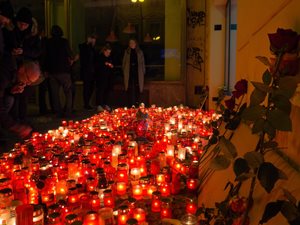The Czech Republic, formerly Czechoslovakia, fell under the influence of the communist Soviet Union that lasted for more than 40 years after WWII. The ‘Iron Curtain’ came down and a barbed-wire fence was erected along the western borders with free Europe. The Czechs did not regain their freedom and democracy until 1989. Each year on 17 November we commemorate the anniversary of the Velvet Revolution, which ended the reign of the Communist regime. But that regime unavoidably stuck in the memory of the Czech people, cities, and the entire country.
Velvet Revolution and Celebrations
 The Communist regime in Czechoslovakia was overthrown by national mass demonstrations that began on 17 November 1989 when the state police took harsh measures against a peaceful demonstration of students. Dozens were injured but no one died – thus the name ‘Velvet’. This year, the street in Prague where it all began – Národní třída – and the nearby Václav Havel Square at the National Theatre will host dozens of concerts, theatre performances, readings of the literary works of Václav Havel (a former prisoner and later Czech President), exhibitions, and events for children as part of Díky, že můžem! (Thanks that we can!). In the evening, the music programme will move to the Rock Café club, a venue founded shortly after the revolution as a spontaneous reaction of former dissent musicians and artists to the newly established freedom on the music scene.
The Communist regime in Czechoslovakia was overthrown by national mass demonstrations that began on 17 November 1989 when the state police took harsh measures against a peaceful demonstration of students. Dozens were injured but no one died – thus the name ‘Velvet’. This year, the street in Prague where it all began – Národní třída – and the nearby Václav Havel Square at the National Theatre will host dozens of concerts, theatre performances, readings of the literary works of Václav Havel (a former prisoner and later Czech President), exhibitions, and events for children as part of Díky, že můžem! (Thanks that we can!). In the evening, the music programme will move to the Rock Café club, a venue founded shortly after the revolution as a spontaneous reaction of former dissent musicians and artists to the newly established freedom on the music scene. Prague Monuments and Museums
Architecture after 1950
The Communist regime did not only turn the political scene upside down in the 1950s, it also fundamentally influenced arts and architecture. An artistic style known as socialist realism came from the Soviet Union. Artists painted images from the countryside or scenes of heavy industry, and abstraction was replaced with realism reminiscent of the early 19th century, the only difference being the inclusion of women tempering steel and men shearing large fields. The same approach was reflected in architecture. In Prague, you can find a whole districts built according to the plans of socialist realism. The International Hotel, which is a reduced copy of Moscow skyscrapers, is a notable example. This style expanded even more in Ostrava-Poruba, where a whole district for almost 50,000 people was built in this style. Today, it is a protected monument, documenting the history of that period. However, Moscow was not the only source of inspiration under the communist dictatorship. In the 1960s, the borders opened up somewhat and young architects drew inspiration from the Western style in vogue at the time – Brutalism. The buildings are massive and typically built from concrete, glass, and steel. The style intentionally leaves the building materials in their raw conditions, and the large areas of raw walls contrast with the extremes of glass constructions or small windows. Not many people liked such buildings for their aesthetics, but they are now slowly entering architecture textbooks and their conservation is being discussed. In Prague, you can admire, for example, the New Building of the National Museum, or the Kotva Department Store in the Old Town, and in Karlovy Vary there is the Thermal hotel, the home the Karlovy Vary International Film Festival at the beginning of each summer.
However, Moscow was not the only source of inspiration under the communist dictatorship. In the 1960s, the borders opened up somewhat and young architects drew inspiration from the Western style in vogue at the time – Brutalism. The buildings are massive and typically built from concrete, glass, and steel. The style intentionally leaves the building materials in their raw conditions, and the large areas of raw walls contrast with the extremes of glass constructions or small windows. Not many people liked such buildings for their aesthetics, but they are now slowly entering architecture textbooks and their conservation is being discussed. In Prague, you can admire, for example, the New Building of the National Museum, or the Kotva Department Store in the Old Town, and in Karlovy Vary there is the Thermal hotel, the home the Karlovy Vary International Film Festival at the beginning of each summer.










